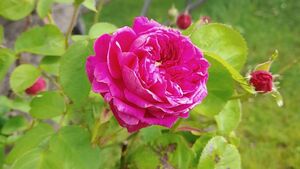The cabin with the roses ‘round the door

While roses have become a popular emblem in our part of the world, their origin begins far from our shores.
I have often rambled among the old derelict cottages of the Ox Mountains, many of them abandoned for decades. Amazingly, it is no surprise to see old roses still blooming among their ruins each summer.
What is it about the rose that captures the imagination? It seems to have an association with so many important things; from feelings of love to pleasant perfume to healing properties.
While roses have become a popular emblem in our part of the world, their origin begins far from our shores. First cultivated in Persia, these flowers were almost immediately given a mythological status. The cultivation of roses spread across many continents, and in almost every culture, they became associated with the gods and royalty.
The rose is said to have been created by Chloris, the goddess of flowers, after she transformed her favourite nymph’s lifeless body into the most stunning, most fragrant bloom imaginable. Such was its magnificence that all of Mount Olympus declared it the queen of flowers, with Mars, the god of war, gifting it thorns for protection.
One Greek myth tells how Aphrodite, the goddess of love, was distraught to hear of a murder plot against Adonis, her mortal lover. In a desperate attempt to warn him, she ran through bushes of white roses and pricked her ankles on their thorns. Her blood turned the petals red, giving the red rose its meaning of eternal devotion.
Nellie Cole, poet, creative, and project coordinator, in a blog, Rose Lore, traces the history of the rose.
The rose, as well as being beautiful and fragrant, also has a variety of medicinal and substance uses. Various parts of rose such as fruits, flowers, leaves, and bark are used in cosmetics, food, and pharmaceuticals. The medical benefits of the rose include the treatment of inflammation, diabetes, depression, stress, and aging. Rose water is a precious beauty treatment for the skin and even has antibacterial benefits.
Irish gardening expert, Gerry Daly, writing in the (August 2019), explains that some varieties of old roses have been around for hundreds of years. They are known as 'cabbage roses', because of the flat cabbage-like shape of the flowers.
Daly goes on to give some expert advice on propagating these old roses.
There are a few old cabbage roses that grow at an old cottage near where I live and when I see them, they always put me in mind of the old song, . The song is a traditional Irish folk song, but its authorship is not definitively attributed to one specific person. It is a simple song that has been passed down through generations, with varying versions and arrangements existing. The song presents an image of a peaceful, idyllic home, adorned with beautiful roses. The song was well established back in 1938 when its lyrics were contributed to the National Folklore Collection by Bridget Magee from a school in Donegal (Schools’ Collection, Volume 1096, Page 461, © National Folklore Collection, UCD).
In my humble opinion, it seems unlikely that it is a true traditional Irish ballad. In all likelihood, the song was the creation of some American lyric writer who was asked to run up a few verses for the lining of a greeting card. I could be wrong about that, but the phrasing and the sentiment seem a little off. The use of the word ‘dame’ and even ‘cabin’ smacks a little of stage Irishness and it is very unlikely that the poor old couple at home in Ireland had the luxury of having any such roses around their door - the existence of their hungry milking goat ensuring that no such shrub could have survived for long.
It would also seem that the song’s rose-tinted view of Old Ireland extended to the creation of these roses in an attempt to ease the heartbreak of separation. The image of an old couple ending their days in a warm cottage overhung with roses is indeed a comforting one and whatever the origin of the song, it became a firm favourite, remaining popular to this day - its enduring appeal most likely stemming from its title, rather that its content. A sweet, up-tempo version of the song by Dana Mulrooney features on YouTube and it is worth a listen.
This summer, if you spot an old rose bush hanging over stone ruins or see a bloom peeping at you through an overgrown roadside hedge, it might be a nice idea to stop and take a cutting. What better way to remember the person who first planted it or the cottage it once adorned… maybe that old couple didn’t have a goat after all.
- Thomas Moore ( )





